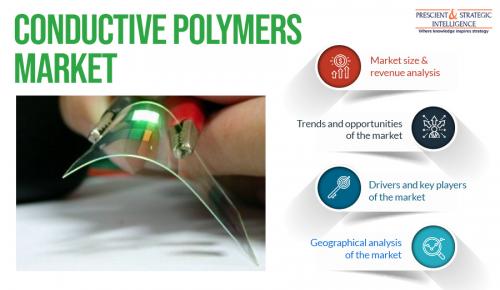Rising Focus over Energy Efficient Technologies Driving Conductive Polymers Market

According to several sources, the world is home to more than 3 billion people with smartphones. Originally introduced to the developed world, they are now more-widely used in developing countries owing to their shifting manufacturing base to the latter and their dropping prices as a result. Moreover, people around the world are witnessing a rise in their purchasing power, which has played a vital role in propelling the sale of such consumer electronics.
Thus, P&S Intelligence expects the conductive polymers market revenue to grow from $4,441.7 million in 2017 to $7,341.2 million by 2023, at an 8.7% CAGR between 2018 and 2023. This is because these materials have become essential for such products, especially the lightweight and high-performance ones. Simply put, conductive polymers are plastic-like materials that conduct electricity and show optical properties that can be modified as per requirement. Thus, with the rising sale of consumer electronics in emerging economies, the consumption of such materials will only surge.
Another emerging application area of such materials is prosthetics and artificial limbs. Here, conductive polymers could help modify the shape and size of muscles and artificial limbs as per the stimulus coming from the human brain. Being organic, such materials would be readily accepted by the host’s immune system. Moreover, by bonding biologically useful molecules to such materials, their properties could be tailored to a specific purpose. Currently, tissue engineering research is going on to stimulate the cells and tissues attached to such polymers, modify the properties of the polymers themselves after synthesis, and even use them as drug delivery systems.
However, the application where the usage of conductive polymers is set to increase the fastest in the coming years is solar cells. Specifically, these materials are being used in organic, perovskite, and dye-sensitized solar cells. In organic cells, conductive polymers are used as buffer layers, donor layers, and micro/nanostructures in tertiary and binary devices. In perovskite cells, they are used to adjust the crystallization and nucleation processes in perovskite films and as electron and hole transfer materials and interface layers to reduce recombination and improve carrier separation efficiency. Similarly, in dye-sensitized solar cells, they are used as film- and pore-forming agents of photoanode films, flexible substrates, quasi-solid-state electrolyte frameworks, and platinum-free counter electrodes.
Presently, North America is the largest conductive polymers market because of the extensive research being conducted to explore and widen the applications of such materials. The region is home to the most-advanced medical device sector, which is why most of the trials and research activities regarding the usage of conductive polymers in prosthetics and implantable medical devices are being conducted here. In the coming years, the demand for such materials is set to shoot up in Asia-Pacific (APAC), home to the largest consumer electronics sector in the world. Moreover, regional countries are rapidly creating solar power plants, which are a key application area of conductive polymers.
Therefore, with continuous research being undertaken to come up with advanced materials for a number of applications, the demand for conductive polymers will only increase.
Advertise on APSense
This advertising space is available.
Post Your Ad Here
Post Your Ad Here
Comments